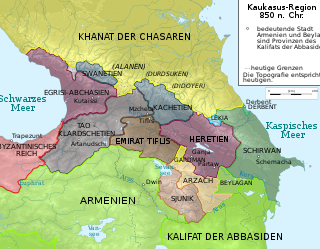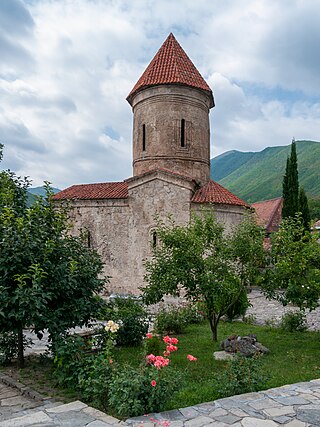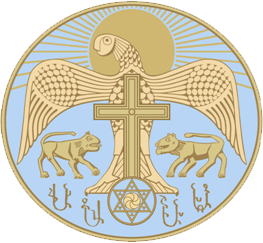
Caucasian Albania is a modern exonym for a former state located in ancient times in the Caucasus, mostly in what is now Azerbaijan. The modern endonyms for the area are Aghwank and Aluank, among the Udi people, who regard themselves as descended from the inhabitants of Caucasian Albania. However, its original endonym is unknown.

Artsakh was the tenth province (nahang) of the Kingdom of Armenia from c. 189 BC until 387 AD, when it was made part of Caucasian Albania, a subject principality of the Sasanian Empire, following the Peace of Acilisene. From the 7th to 9th centuries, it fell under Arab control. In 821, it formed the Armenian principality of Khachen and around the year 1000 was proclaimed the Kingdom of Artsakh, one of the last medieval eastern Armenian kingdoms and principalities to maintain its autonomy following the Turkic invasions of the 11th to 14th centuries.

The Kingdom of Hereti was a medieval monarchy which emerged in Caucasus on the Iberian-Albanian frontier. Nowadays it roughly corresponds to the southeastern corner of Georgia's Kakheti region and a portion of Azerbaijan's northwestern districts.

Juansher was the Mihranid prince of Caucasian Albania, ruling the principality from 637 to 669. He was the son and successor of Varaz Grigor.

Utik was a historic province of the Kingdom of Armenia. It was ceded to Caucasian Albania following the partition of Armenia between Sassanid Persia and the Eastern Roman Empire in 387 AD. Most of the region is located within present-day Azerbaijan immediately west of the Kura River, while a part of it lies within the Tavush province of present-day northeastern Armenia.
Movses Kaghankatvatsi, or Movses Daskhurantsi is the reputed author of a tenth-century Classical Armenian historiographical work on Caucasian Albania and eastern provinces of Armenia, known as The History of the Country of Albania.

The Church of Kish, also known from different sources as Church of Saint Elishe or Holy Mother of God Church, is a Georgian Orthodox church, probably dating to the early 12th century, inactive due to lack of parishioners since the 19th century, although -as of 2000- mass was still regularly held by a Georgian priest. It is located in the village of Kiş approximately 5 km north of Shaki, Azerbaijan. Archaeological research undertaken in 2000 concluded that it was first built as a diophysite Georgian church, later to become a Chalcedonian church. Previous research had proposed that it had functioned at different times as a Caucasian Albanian Apostolic church, a Chalcedonian church within the Georgian Orthodox Church, and later as an Armenian Apostolic Church.

Hasan-Jalalyan was a medieval Armenian dynasty that ruled over parts of the South Caucasus. From the early thirteenth century, the family held sway in Khachen in what are now the regions of lower Karabakh, Nagorno-Karabakh, and Syunik in modern Armenia. The family was founded by Hasan-Jalal Dawla, an Armenian feudal prince from Khachen. The Hasan-Jalalyans maintained their autonomy over the course of several centuries of nominal foreign domination by the Seljuk Turks, Persians and Mongols. They, along with the other Armenian princes and meliks of Khachen, saw themselves as holding the last bastion of Armenian independence in the region.
The Mihranids were an Iranian family which ruled several regions of Caucasus from 330 to 821. They claimed to be of Sasanian Persian descent but were of Parthian origin.
Sahl Smbatean Eṙanshahik was an Armenian prince of Arran and Shaki who played a considerable role in the history of the eastern Caucasus during the 9th century and was the ancestor of the House of Khachen established in 821.
The Church of Albania or the Albanian Apostolic Church was an ancient, briefly autocephalous church established in the 5th century. In 705, It fell under the religious jurisdiction of the Armenian Apostolic Church as the Catholicosate of Aghvank centered in Caucasian Albania, a region spanning present-day northern Azerbaijan and southern Dagestan.
Varaz Grigor was the first known Mihranid king of Caucasian Albania from 628 until at least 654. The last holder of the title was Vachagan III.
Atrnerseh was an Armenian ruler of the Principality of Khachen. He was the son and successor of Sahl Smbatean.
Sahak Sevada was ruler of Gardman between 895–940 and father-in-law of King Ashot II of Armenia. He was the son of Grigol Hamam and brother of Atrnerseh, ruler of Hereti. His possessions covered Parisos, a district of Artsakh, as well as part of Utik-Gardman and Dzoroget.
In the history of Azerbaijan, the Early Middle Ages lasted from the 3rd to the 11th century. This period in the territories of today's Azerbaijan Republic began with the incorporation of these territories into the Sasanian Persian Empire in the 3rd century AD. Feudalism took shape in Azerbaijan in the Early Middle Ages. The territories of Caucasian Albania became an arena of wars between the Byzantine Empire and the Sassanid Empire. After the Sassanid Empire was felled by the Arab Caliphate, Albania also weakened and was overthrown in 705 AD by the Abbasid Caliphate under the name of Arran. As the control of the Arab Caliphate over the Caucasus region weakened, independent states began to emerge in the territory of Azerbaijan.
The Lupenians or Lpins were a historical tribe that lived in modern-day Republic of Azerbaijan in antiquity. The Lupenians were mentioned in several sources in different languages. They are equated with Pliny's Lupenii, dwelling south of the tribe of Silvii (Chola), just next to the Diduri and near the frontier of Caucasian Albania. Agathangelos renders their name in Greek as Lifénnioi. The Ravenna Cosmography mentions their land as "Patria Lepon" situated next to Iberia and the Caspian Sea. The Tabula Peutingeriana also mentions the Lupenii. Vladimir Minorsky proposed later Arabic versions as well. They were probably related to the Caucasian Albanians.
Nerses Bakur was the Catholicos and head of Caucasian Albanian Church in the late 7th and early 8th century.

P'arisos was a city, fortress, and monastery located in the upper basin of the Shamkir river, near the present-day Azerbaijani village of Qalakənd. The ruins of P'arisos are located on a crag on the left bank of a stream also historically called P'arisos, which is itself a tributary of the Shamkir. P'arisos was also the name of the surrounding district, which comprised the Shamkir basin, and of a kingdom whose capital was here. The kingdom of P'arisos became the most important principality in the eastern Armenian highlands during the 10th century.
Vardan II - was the Mihranid king of Caucasian Albania from 705 to 711.
Stephanos I was the Mihranid king of Caucasian Albania from 770 to 800 and the son of the previous ruler Gagikh II.







